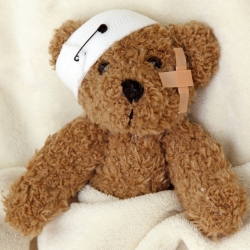 All doctors have a responsibility to protect children and young people from abuse or neglect. Charlotte Hudson explores guidance surrounding child protection.
All doctors have a responsibility to protect children and young people from abuse or neglect. Charlotte Hudson explores guidance surrounding child protection.
Child abuse hit the headlines almost 40 years ago when the death of Maria Colwell shocked the nation, after which there were several high profile cases, including Heidi Koseda and Jasmine Beckford, before the Victoria Climbie findings generated the government legislation Every Child Matters. But, children are still being put at unnecessary risk because professionals involved in their care do not recognise the signs, or fail to take appropriate action.
The most prominent recent case was that of Baby P who was killed by his mother, her boyfriend and his brother after months of abuse, in 2007. All the healthcare professionals involved in Baby P’s care were scrutinised, including Baby P’s GP. He was found guilty of a serious breach of professional duty for missing the signs of abuse, when he failed to properly examine Baby P or refer him for an urgent assessment after finding bruises on the child’s head and chest after apparently falling down the stairs. Had he taken the appropriate steps such appalling abuse – and his death – could have been prevented. An Ofsted report released in 20111 looked at hundreds of cases in which babies and young people suffered death or serious injury at the hands of their parents – known as serious case reviews, between 2007 and 2011.
In one case, a depressed mother suffocated her baby, after doctors and health workers had been so worried about protecting her privacy that they failed to report that she could be a risk to her child. The inquiry found ‘repeated examples of agencies underestimating the risks from parents’ background and lifestyle’, including drug or alcohol misuse and being abused as a child.
New guidance from the GMC, Protecting children and young people: The responsibilities of all doctors (2012)2, states that if doctors are treating an adult patient, they must consider whether the patient poses a risk to children or young people, and they must be able to identify risk factors in a patient’s environment that might raise concerns about abuse or neglect.
WHAT SHOULD YOU DO IF YOU SUSPECT CHILD ABUSE?
The GMC guidance reinforces the message that doctors must communicate their concerns.
It states: “You must tell an appropriate agency, such as your local authority children’s services, the NSPCC or the police, promptly if you are concerned that a child or young person is at risk of, or is suffering, abuse or neglect, unless it is not in their best interests to do so”.
“It is vital that all doctors have the confidence to act if they believe that a child or young person is being abused or neglected.”
NICE guidance When to suspect child maltreatment (2009)3 states that doctors may sometimes come across many different obstacles in the process of identifying maltreatment, including: discomfort of suspecting or wrongly blaming a parent or carer, divided duties to adult and child patients and breaching confidentiality, and fear of complaints. It says that these should not prevent you from following the appropriate course of action to prevent further harm to the child or young person.
The GMC now makes it clear that doctors should follow up concerns and take them to the next level of authority, if they believe the person or agency to who they have referred the issue has not acted on them appropriately and a child remains at risk of abuse or neglect.
There is now an obligation for all doctors to be aware of services in their locality that can help parents and children if a child is potentially at risk, including services provided by voluntary groups. The GMC also expects doctors to develop an understanding of the practices and beliefs of the different cultural and religious communities that they serve – presenting a challenge for doctors who work in ethnically diverse areas.
In hospital, paediatricians and emergency medics are in a prime position to pick up signs of abuse or violence and refer to other agencies when young people present with injuries, or signs of grooming when young people present with alcohol or drug related issues.
If you suspect abuse, you should highlight your concerns to the designated lead for child protection in your unit. You need to be aware of the trust policy on child protection, and who to contact and how. Junior doctors should make sure they seek advice from seniors when appropriate.
It is your professional responsibility to act if you suspect child abuse or neglect. You will be able to justify your actions if a complaint is made about you – provided your conclusions are honestly held, have been pursued through the appropriate channels and in accordance with the GMC guidance.
WHAT ARE THE SIGNS?
The Royal College of Paediatrics and Child Health (RCPCH) work to prevent and respond to abuse and neglect. They state that the four types of abuse are: physical, sexual, emotional and neglect (as defined in the UK government guidance Working Together to Safeguard Children 2010).
NSPCC guidance4 states that there are a number of physical signs that may indicate abuse, including unexplained bruising, marks or injuries on any part of the body or human bite marks. Changes in behaviour can also indicate physical abuse, eg, flinching when approached or touched.
Changes in behaviour which can indicate emotional abuse include neurotic behaviour and self-harm. Usually, in cases of sexual abuse it is the child’s behaviour that may cause you to become concerned, although physical signs can also be present.
Neglect can be a difficult form of abuse to recognise; signs can include constant hunger, poor personal hygiene, along with changes in behaviour, such as being tired all the time.
MPS Director of Policy, Communications and Marketing, Dr Stephanie Bown, said: “On the one hand doctors can be condemned if they don’t spot abuse or neglect, but on the other hand, they could also find themselves subject to a complaint if they raise concerns about parents or careers.
“What the GMC’s new guidance makes clear is that doctors have to put the interests of the child or young person first, and this of course is what they will be judged against.”
HOW TO IDENTIFY CHILD MALTREATMENT
NICE guidance says:
- Listen to and gather information to create a full picture
- Seek an explanation in an open manner
- Record in the child’s medical record what is observed and heard from whom and when
- Discuss your concerns with a more experienced colleague or named professional for safeguarding children.
Further information on child protection can be found in the MPS factsheet, Safeguarding Children – http://www.medicalprotection.org/uk/england-factsheets/safeguarding-children.
REFERENCES:
- Ofsted, Ages of concern: learning lessons from serious case reviews – www.ofsted.gov.uk
- GMC, Protecting children and young people: the responsibilities of all doctors 2012 – www.gmc-uk.org
- NICE, When to suspect child maltreatment CG89 – www.nice.org.uk/cg89
- NSPCC, Child protection fact sheet, The definitions and signs of child abuse – www.nspcc.org.uk/inform



